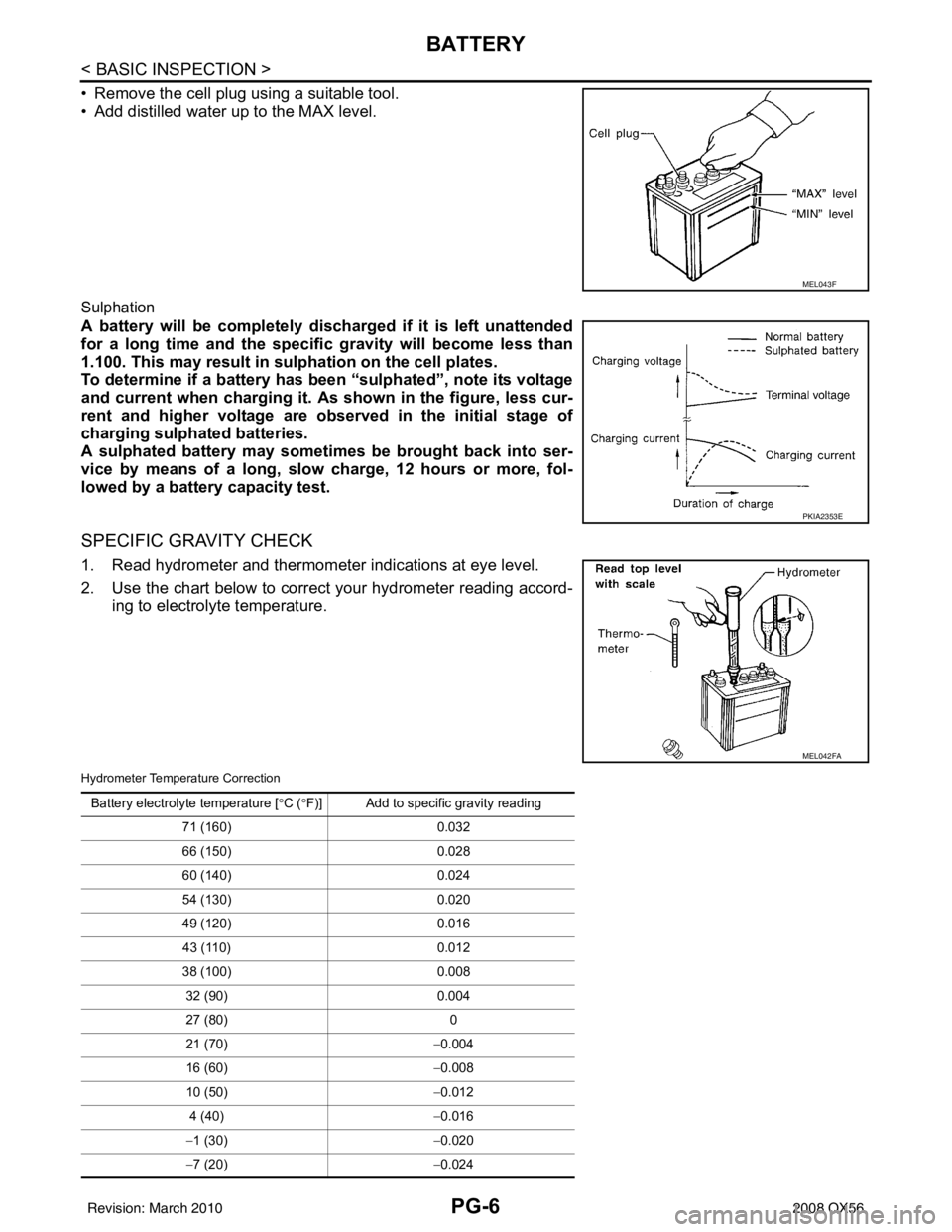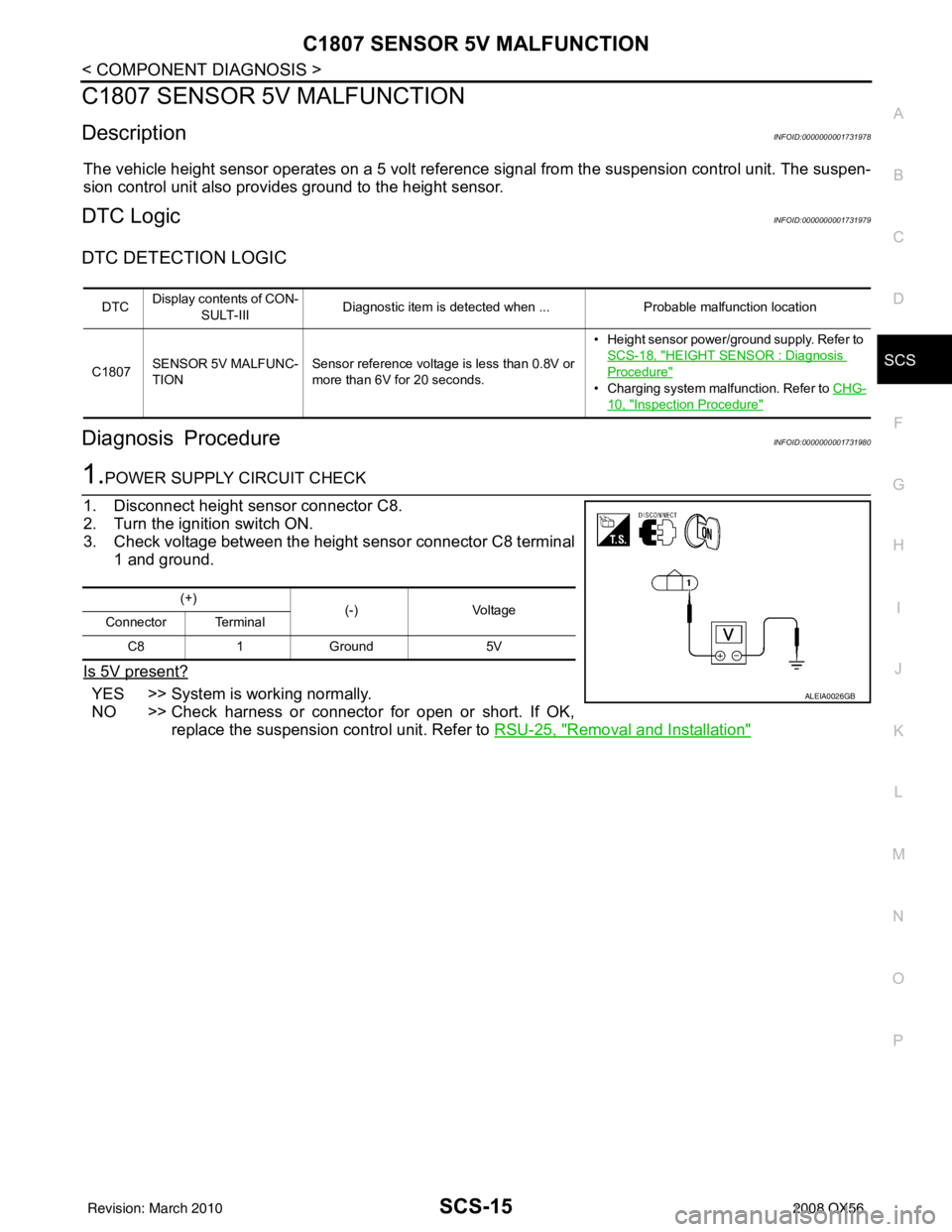Page 2771 of 4083
PG-4
< PREPARATION >
PREPARATION
PREPARATION
PREPARATION
Special Service ToolINFOID:0000000001538889
The actual shapes of Kent-Moore tools may differ from those of special service tools illustrated here.
Commercial Service ToolINFOID:0000000001538890
Tool number
(Kent-Moore No.)
Tool name Description
—
(J-48087)
Battery Service Center Te s t s b a t t e r y.
For operating instructions, refer to Technical
Service Bulletin and Battery Service Center
User Guide.
—
(J-44373) Model 620
Starting/Charging system tester Tests starting and charging systems.
For operating instructions, refer to Technical
Service Bulletin.
WKIA5280E
SEL403X
Tool name
Description
Power tool Loosening bolts and nuts
PBIC0190E
Revision: March 2010 2008 QX56
Page 2772 of 4083

PG
BATTERYPG-5
< BASIC INSPECTION >
C
DE
F
G H
I
J
K L
B A
O P
N
BASIC INSPECTION
BATTERY
How to Handle BatteryINFOID:0000000001696239
CAUTION:
• If it becomes necessary to start the engine with
a booster battery and jumper cables, use a 12-volt
booster battery.
• After connecting battery cables, ensure that they are tightly clamped to battery terminals for good
contact.
• Never add distilled water through the hole used to check specific gravity.
METHODS OF PREVENTING OVER-DISCHARGE
The following precautions must be taken to prevent over-discharging a battery.
• The battery surface (particularly its top) should always be kept
clean and dry.
• The terminal connections should be clean and tight.
• At every routine maintenance, check the electrolyte level. This also applies to batteries designated as “low maintenance” and
“maintenance-free”.
• When the vehicle is not going to be used over a long period of time, disconnect the battery cable from the negative terminal. (If
the vehicle has an extended storage switch, turn it off.)
• Check the charge condition of the battery. Periodically check the specific gr avity of the electrolyte. Keep a
close check on charge condition to prevent over-discharge.
CHECKING ELECTROLYTE LEVEL
WARNING:
Never allow battery fluid to come in contact with skin, eyes, fabrics, or painted surfaces. After touch-
ing a battery, never touch or rub your eyes until you have thoroughly washed your hands. If acid con-
tacts eyes, skin or clothing, imme diately flush with water for 15 minutes and seek medical attention.
MEL040F
ELA0349D
MEL042F
Revision: March 2010 2008 QX56
Page 2773 of 4083

PG-6
< BASIC INSPECTION >
BATTERY
• Remove the cell plug using a suitable tool.
• Add distilled water up to the MAX level.
Sulphation
A battery will be completely discharged if it is left unattended
for a long time and the specific gravity will become less than
1.100. This may result in sulphation on the cell plates.
To determine if a battery has been “sulphated”, note its voltage
and current when charging it. As shown in the figure, less cur-
rent and higher voltage are observed in the initial stage of
charging sulphated batteries.
A sulphated battery may sometimes be brought back into ser-
vice by means of a long, slow charge, 12 hours or more, fol-
lowed by a battery capacity test.
SPECIFIC GRAVITY CHECK
1. Read hydrometer and thermometer indications at eye level.
2. Use the chart below to correct your hydrometer reading accord- ing to electrolyte temperature.
Hydrometer Temperature Correction
MEL043F
PKIA2353E
MEL042FA
Battery electrolyte temperature [° C (°F)] Add to specific gravity reading
71 (160) 0.032
66 (150) 0.028
60 (140) 0.024
54 (130) 0.020
49 (120) 0.016
43 (110) 0.012
38 (100) 0.008
32 (90) 0.004
27 (80) 0
21 (70) −0.004
16 (60) −0.008
10 (50) −0.012
4 (40) −0.016
− 1 (30) −0.020
− 7 (20) −0.024
Revision: March 2010 2008 QX56
Page 2774 of 4083

PG
BATTERYPG-7
< BASIC INSPECTION >
C
DE
F
G H
I
J
K L
B A
O P
N
CHARGING THE BATTERY
CAUTION:
• Never “quick charge” a fully discharged battery.
• Keep the battery away from open flame while it is being charged.
• When connecting the charger, connect
the leads first, then turn on the charger. Never turn on the
charger first, as this may cause a spark.
• If battery electrolyte temperature rises above 55 °C (131 °F), stop charging. Always charge battery at
a temperature below 55 °C (131 °F).
Charging Rates
Do not charge at more than 50 ampere rate.
NOTE:
The ammeter reading on your battery charger will automatically decrease as the battery charges. This indi-
cates that the voltage of the battery is increasing norma lly as the state of charge improves. The charging amps
indicated above refer to initial charge rate.
• If, after charging, the specific gravity of any two cells varies more than 0.050, the battery should be replaced.
Work FlowINFOID:0000000001696240
TROUBLE DIAGNOSIS WITH BATTERY SERVICE CENTER
For battery testing, use Battery Service Center (J-48087). For details and operating instructions, refer to Tech-
nical Service Bulletin and/or Battery Service Center User Guide.
− 12 (10) −0.028
− 18 (0) −0.032
Battery electrolyte temperature [
°C ( °F)] Add to specific gravity reading
Corrected specific gravity Approximate charge condition
1.260 - 1.280 Fully charged
1.230 - 1.250 3/4 charged
1.200 - 1.220 1/2 charged
1.170 - 1.190 1/4 charged
1.140 - 1.160 Almost discharged
1.110 - 1.130 Completely discharged
Amps Time
50 1 hour
25 2 hours
10 5 hours
5 10 hours
Revision: March 2010 2008 QX56
Page 3097 of 4083

SCS-14
< COMPONENT DIAGNOSIS >
C1806 VEHICLE HEIGHT SENSOR LOCKING MALFUNCTION
C1806 VEHICLE HEIGHT SENSOR LOCKING MALFUNCTION
DescriptionINFOID:0000000001731975
The vehicle height sensor operates on a 5 volt referenc e signal from the suspension control unit. The suspen-
sion control unit also provides ground to the height sensor.
DTC LogicINFOID:0000000001731976
DTC DETECTION LOGIC
Diagnosis ProcedureINFOID:0000000001731977
1.CHECK HEIGHT SENSOR OPERATION
CONSULT-III
1. Turn ignition switch ON
2. Select "HEIGT SEN" of AIR LEVELIZER data monitor test item.
Is the HEIGHT SEN voltage within the given range?
YES >> Height sensor is operating normally.
NO >> Refer to SCS-22, "
Diagnosis Procedure".
DTCDisplay contents of CON-
SULT-III Diagnostic item is detected when ...
Probable malfunction location
C1806 VEHICLE HEIGHT SEN-
SOR LOCKING MAL-
FUNCTION Output sensor voltage variation
±0.02V is more
than 100 seconds when vehicle height range is
normal. • Height sensor power/ground supply. Refer to
SCS-18, "
HEIGHT SENSOR : Diagnosis
Procedure"
• Charging system malfunction. Refer to CHG-
10, "Inspection Procedure"
HEIGHT SEN : 0.2V - 4.8V with no more than ± 0.02V
variation
Revision: March 2010 2008 QX56
Page 3098 of 4083

C1807 SENSOR 5V MALFUNCTIONSCS-15
< COMPONENT DIAGNOSIS >
C
DF
G H
I
J
K L
M A
B
SCS
N
O P
C1807 SENSOR 5V MALFUNCTION
DescriptionINFOID:0000000001731978
The vehicle height sensor operates on a 5 volt referenc e signal from the suspension control unit. The suspen-
sion control unit also provides ground to the height sensor.
DTC LogicINFOID:0000000001731979
DTC DETECTION LOGIC
Diagnosis ProcedureINFOID:0000000001731980
1.POWER SUPPLY CIRCUIT CHECK
1. Disconnect height sensor connector C8.
2. Turn the ignition switch ON.
3. Check voltage between the height sensor connector C8 terminal 1 and ground.
Is 5V present?
YES >> System is working normally.
NO >> Check harness or connector for open or short. If OK, replace the suspension control unit. Refer to RSU-25, "
Removal and Installation"
DTCDisplay contents of CON-
SULT-III Diagnostic item is detected when ...
Probable malfunction location
C1807 SENSOR 5V MALFUNC-
TION Sensor reference voltage is less than 0.8V or
more than 6V for 20 seconds. • Height sensor power/ground supply. Refer to
SCS-18, "
HEIGHT SENSOR : Diagnosis
Procedure"
• Charging system malfunction. Refer to CHG-
10, "Inspection Procedure"
(+)
(-) Voltage
Connector Terminal
C8 1 Ground 5V
ALEIA0026GB
Revision: March 2010 2008 QX56
Page 3532 of 4083

PRECAUTIONSSTR-3
< PRECAUTION >
C
DE
F
G H
I
J
K L
M A
STR
NP
O
5. When the repair work is completed, return the ignition switch to the
″LOCK ″ position before connecting
the battery cables. (At this time, the steering lock mechanism will engage.)
6. Perform a self-diagnosis check of al l control units using CONSULT-III.
Precaution for Power Generation Variable Voltage Control SystemINFOID:0000000001538874
CAUTION:
For this model, the battery current sensor that is installed to the negative battery cable measures the
charging/discharging current of the battery and performs various engine controls. If an electrical com-
ponent is connected directly to the negative battery terminal, the current flowing through that compo-
nent will not be measured by the battery current sensor. This condition may cause a malfunction of
the engine control system and battery discharge m ay occur. Do not connect an electrical component
or ground wire directly to the battery terminal.
Revision: March 2010 2008 QX56
Page 3533 of 4083
STR-4
< PREPARATION >
PREPARATION
PREPARATION
PREPARATION
Special Service ToolINFOID:0000000001538875
The actual shapes of Kent-Moore tools may differ from those of special service tools illustrated here.
Commercial Service ToolINFOID:0000000001538876
Tool number
(Kent-Moore No.)
Tool name Description
—
(J-48087)
Battery Service Center Te s t s b a t t e r y.
For operating instructions, refer to Technical
Service Bulletin and Battery Service Center
User Guide.
—
(J-44373) Model 620
Starting/Charging system tester Tests starting and charging systems.
For operating instructions, refer to Technical
Service Bulletin.
WKIA5280E
SEL403X
Tool name
Description
Power tool Loosening bolts and nuts
PBIC0190E
Revision: March 2010 2008 QX56